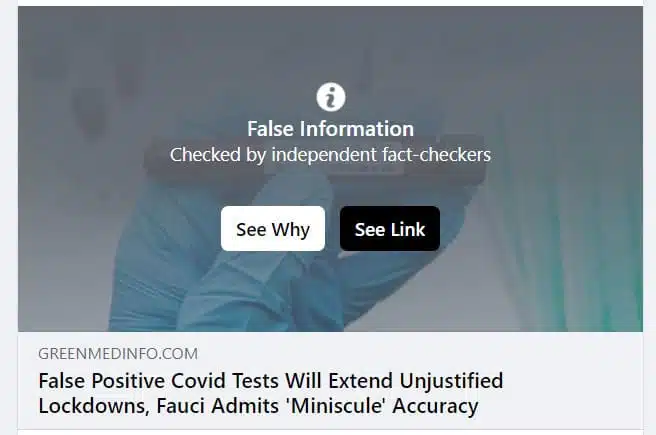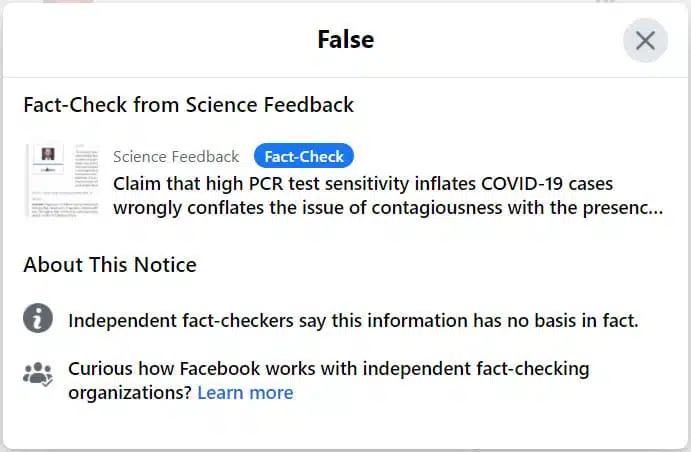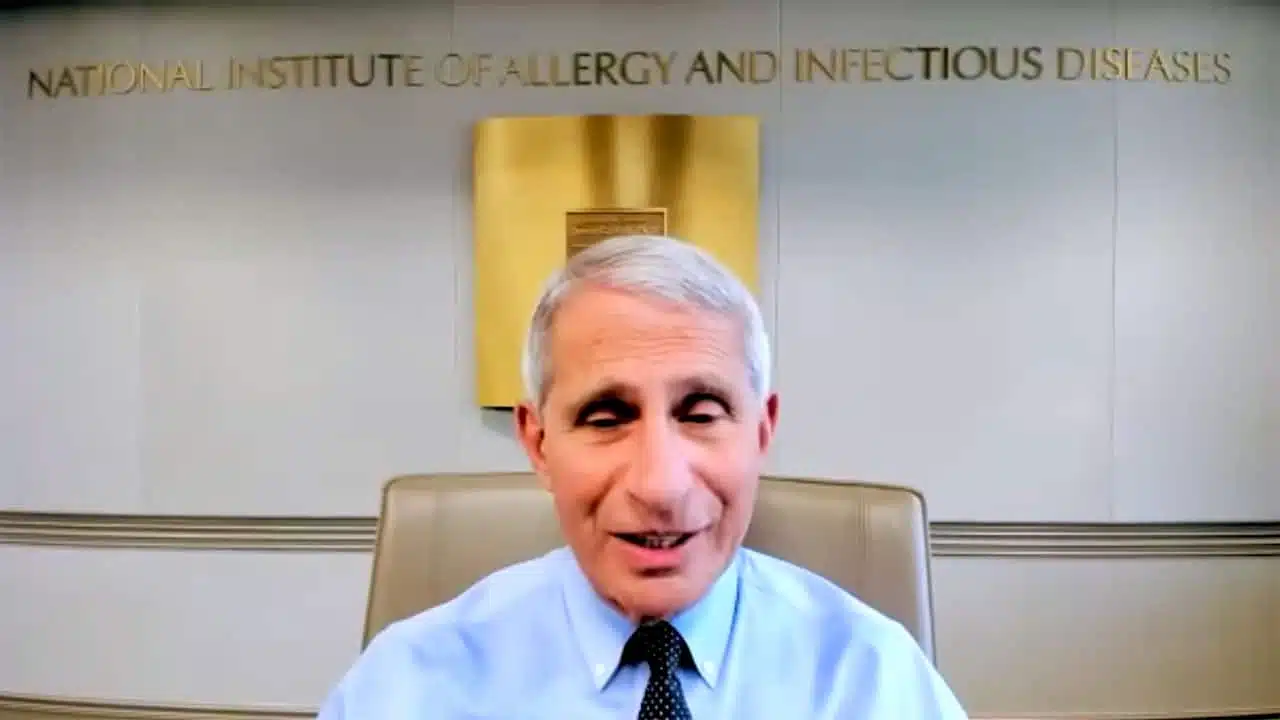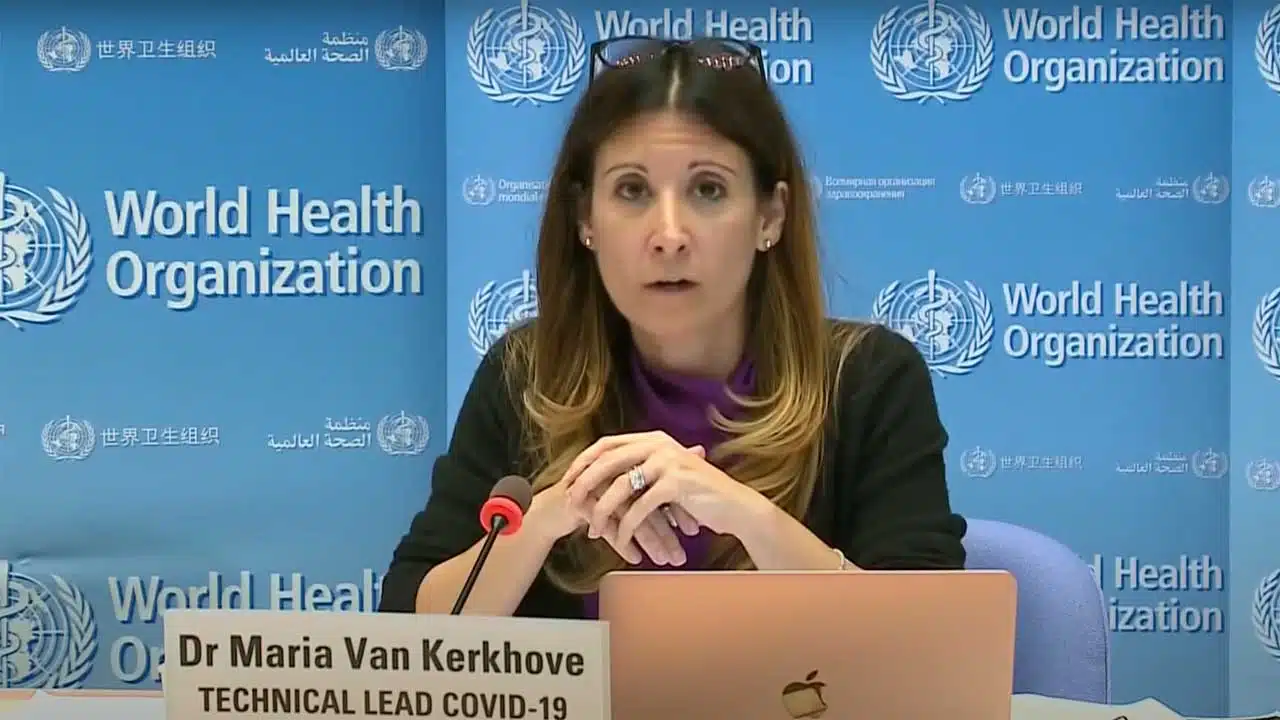Table of Contents
Introduction
Facebook’s “fact checking” feature is ostensibly intended to prevent users from becoming misinformed about important matters, but it is instead being used as a tool for political propaganda and censorship of truthful information that does not align with certain political agendas.
Among other agendas, Facebook has been serving to manufacture consent for extreme “lockdown” measures in response to the epidemic of coronavirus disease 2019 (COVID-19), which is the disease caused by the severe acute respiratory syndrome coronavirus 2 (SARS-CoV-2).
This is evident in how only information challenging lockdown policies is apparently being flagged as misinformative despite the massive amount of misinformation being propagated by lockdown advocates in the mainstream media.
Indeed, it is evident in how Facebook itself demonstrably misinforms its users through its “fact check” feature.
A recent example is a November 12 article by Facebook’s “fact checking” partner Health Feedback that tries vainly to defend the unscientific practice of treating every positive PCR test as a “COVID-19 case”, the numbers of which are in turn being used to justify continuation or reimplementation of authoritarian lockdown measures.
The Role of PCR Tests in the Shifted Justification for Lockdown Measures
Lockdown measures were initially sold to the public as a strictly temporary means to allow hospitals time to procure personal protective equipment (PPE) and expand bed capacity. The idea was to “flatten the curve”, meaning to prevent a short, sharp spike of cases that would overwhelm hospitals, by reducing transmission with measures intended to prolong the duration of the epidemic wave.
Flattening the curve was not about preventing cases of COVID-19. The total area under the hypothetical curves would be the same; it would just be flatter and more drawn out under the “lockdown” scenario. The idea was not to save lives by reducing the total number of cases but by reducing excess deaths due to lack of access to medical treatment during the initial wave.
However, the measures persisted, with the justification soon shifting from a need to “flatten the curve” to a need to reduce “cases” indefinitely and regardless of hospitals’ ability to cope with patient numbers. Here in Michigan, for example, Governor Gretchen Whitmer in May declared the faith-based policy goal of reducing cases to “nearly zero” by keeping lockdown measures in place until a vaccine gets to market that will save us all.
The numbers of COVID-19 “cases”, in turn, are being determined primarily through the use of tests known as reverse transcription polymerase chain reaction (RT-PCR) assays, which detect the presence of ribonucleic acid (RNA) unique to the novel coronavirus SARS-CoV-2.
The problem with this practice is that PCR tests by themselves cannot determine whether a patient has COVID-19. Just because a PCR test is positive does not mean that the individual being tested has the disease.
That is the truth that Facebook and its “fact-checking” partner Health Feedback are now trying to conceal from the public by censoring articles that point out the problem while outright lying that a positive PCR test necessarily equals a “COVID-19 case”.
Facebook’s Censorship
On November 16, I observed Facebook censoring content by covering it with a warning that it was “False Information”. The content has been “Checked by independent fact-checkers”, the warning states. The user is then allowed to select between viewing information about why the content is false or proceeding to view the content.

While users may still view the linked article, the warning prejudices the reader against the content so that they are less likely to do so.
Additionally, when it flags posts, administrators of Facebook groups in which the allegedly false information has been posted are notified,
To fight false news, Facebook pushes misleading content farther down in News Feed and provides additional articles on the same topic. If a group repeatedly shares false news, Facebook may push all of that group’s content down in News Feed, which may mean fewer people visit the group. Facebook may also stop suggesting that people join the group.

When clicking the button to “See Why” the content is supposedly false, in this instance, Facebook told me that the linked article is “False” and directed me to a “Fact-Check from Science Feedback”, where “Independent fact-checkers say this information has no basis in fact.”

The link is to a November 12 article in Science Feedback’s publication Health Feedback titled “Claim that high PCR test sensitivity inflates COVID-19 cases wrongly conflates the issue of contagiousness with the presence of infection”.
Another link goes to a Facebook Help Center page declaring, “We’re committed to fighting the spread of false information on Facebook.”
But that is demonstrably untrue. In fact, it is Facebook and Health Feedback who are in this instance grossly misinforming the public. The claim that this “fact-check” article makes, that a positive PCR test necessarily means that the person tested has COVID-19, is false. In order to make that argument, it is Health Feedback that wrongly conflates infection with disease.
The corollary is that Facebook and its faux “fact check” partner have no problem at all with misinformation, provided that it serves a political agenda for which they desire to manufacture consent.
The Censored Content
The article that I observed Facebook flagging as “false” is titled “False Positive Covid Tests Will Extend Unjustified Lockdowns, Fauci Admits ‘Miniscule Accuracy”, written by The Highwire reporter Jefferey Jaxen. (The link in this case was to the article at GreenMedInfo, where it was republished from The Highwire website.)
That article covers the same topic but is not specifically referenced by Health Feedback, which instead refers to an article from Just the News written by Daniel Payne and titled “In newly surfaced July interview, Fauci warns that widely used COVID tests may pick up ‘dead’ virus”.
The specific information quoted from Payne’s article that Health Feedback and Facebook are claiming is false is this:
. . . Dr. Anthony Fauci appeared to acknowledge that large numbers of positive COVID-19 cases may arise from oversensitive tests that pick up mere fragments of the virus rather than active, viable infections. If true, many patients may have been receiving false-positive test results—causing much needless anxiety and disruption to everyday life—while the numbers of COVID-19 cases reported by public health authorities and major COVID tracking websites could be vastly overstated.
Payne was citing an interview with Fauci, who is the director of the National Institute for Allergic and Infectious Disease (NIAID) under the National Institutes of Health (NIH) and a member of the White House coronavirus task force, on a This Week in Virology (TWiV) podcast published on YouTube on July 16.
Jaxen cites the same interview in his article, providing a Twitter post with an embedded excerpt of the relevant portion of the interview about PCR tests, in which Fauci states,
What is now sort of evolving into a bit of a standard that if you get a cycle threshold of 35 or more, that the chances of it being replication competent are miniscule, so that if somebody—and you know, we do, we have patients, and it’s very frustrating for the patients as well as for the physicians, somebody comes in and they repeat their PCR and it’s like 37 cycle threshold—but you never, you almost never can culture from a 37 threshold cycle. So I think that if somebody does come in with 37, 38, even 36, you gotta say, you know, it’s just dead nucleotides, period.
As both Payne and Jaxen rightly observe, the consequence of this oversensitivity is that people are being counted as “COVID-19 cases” based on a “positive” PCR test even if detects only non-viable viral fragments that are incapable of infection.
As Health Feedback concisely and accurately explains (emphasis added),
The podcast discussed COVID-19 testing and the value of the PCR test to inform tested individuals about what measures they should take. The PCR test detects the presence of the virus by amplifying a small part of the virus’ genetic material. The number of amplification cycles needed to arrive at a level considered to be a “positive” result is also called the cycle threshold (Ct) value.
The Ct value depends on the quantity of virus in a sample. The more virus present, the fewer amplification cycles are needed to reach the level for a positive result, while a low viral load requires more amplification cycles to reach that same level. Whether one has a high or low Ct determines whether contact tracing and self-isolation measures would be useful. This is because high viral load (low Ct value) likely indicates that a person is infectious, whereas a low viral load (high Ct value) likely indicates that a person is not infectious or has low transmissibility.
Health Feedback again acknowledges, “the PCR test cannot distinguish between infectious and ‘dead’ (non-infectious) virus.”
However, Facebook’s “fact check” partner goes on to argue that “several outlets, including Just the News, incorrectly interpreted this information to suggest that the PCR test’s high sensitivity is responsible for inflating the number of COVID-19 cases reported in the U.S. and that the true number of infections is smaller than reported figures indicate.” (Emphasis added.)
Health Feedback’s False “Fact-Check”
Notice that the words “cases” and “infections” are treated synonymously by Health Feedback, which adds that the supposedly false claim “fails to distinguish between the test’s ability to confirm a COVID-19 infection—which is what case numbers measure—with the test’s ability to determine contagiousness”. (Emphasis added.)
By Health Feedback’s reasoning, “It is inaccurate to label these high Ct positive results as ‘false positives’. The term ‘false positive’ indicates that a person tested positive but does not have the disease.” (All emphasis added.)
Regardless of the Ct value, the article argues, a person who tests positive “is or has been infected” (emphasis added).
“Therefore,” the article concludes, “the sensitivity of the PCR test is not responsible for the high number of COVID-19 cases in the U.S. Simply put, COVID-19 case numbers are high because there are many infected people.” (Emphasis added.)
Health Feedback proceeds to identify the political agenda for which consent is being manufactured through its fallacious and deceptive argument (all emphasis added):
This indicates a high level of virus transmission in the community and public health measures, such as physical distancing and lockdowns, are effective and important for reducing the number of COVID-19 infections and protecting the community.
“In summary,” the article reiterates, “the claim that the COVID-19 case counts in the U.S. are inflated because of the PCR test’s sensitivity is based on an inaccurate and misleading conflation of contagiousness with the presence of infection.” (Emphasis added.)

However, it is Health Feedback’s own argument that is fallacious. This is what’s known as a “strawman” argument: instead of addressing the true point being made, Health Feedback has set up an imaginary opposing claim and falsely attributed it to the articles being censored by Facebook. By this means, the “fact check” partners are deflecting attention from the real issue.
In this case, it’s a strawman built on a false premise. Indeed, to accomplish its deflection, Health Feedback outright lies to its readers by insisting that a positive PCR test necessarily means a “COVID-19 case”.
What both Payne and Jaxen reported was that PCR tests overinflate COVID-19 cases. This is not the same thing as saying that the tests overinflate SARS-CoV-2 infections. The problem is not that Payne and Jaxen have conflated contagiousness with infection. (They do not.) The problem is that Health Feedback has wrongly conflated infection with disease.
Why a Positive PCR Test Does Not Equal a “COVID-19 Case”
In the Glossary of its medical textbook Principles of Epidemiology in Public Health Practice, the US Centers for Disease Control and Prevention (CDC) defines “clinical disease” as “a disease that has been manifested by its symptoms and features”. (Emphasis added.)
A “case” is “an instance of a particular disease, injury, or other health conditions that meets selected criteria”. (Emphasis added.)
By contrast, “infection” is defined as “invasion of the body tissues of a host by an infectious agent, whether or not it causes disease”. (Emphasis added.)
A “case definition” is “a set of uniformly applied criteria for determining whether a person should be identified as having a particular disease, injury, or other health condition.” (Emphasis added.)
The CDC’s case definition for “COVID-19” establishes the clinical criteria for a COVID-19 diagnosis: it requires an infected individual to have symptoms to be counted as a “case”.
The CDC’s case definition also mentions the proper role of PCR tests, which is only to confirm a diagnosis—not as the sole basis for diagnosing a case of COVID-19.
Thus, the term “infection” is not synonymous with “disease”; a person may be infected with SARS-CoV-2 and yet not have COVID-19; and a positive PCR test does not necessarily mean that the individual tested has the disease.

Health Feedback’s false claim that a positive PCR test means the person has COVID-19 rests on fallaciously equating those terms as well as conflating the name of the virus with the name of the disease—such as its use of the term “COVID-19 infection”.
What Health Feedback means is “SARS-CoV-2 infection”, which is not “what case numbers measure”. While all cases of COVID-19 necessarily also represent a case of infection, not all infections represent a case of COVID-19.
Nevertheless, in defiance of the CDC’s case definition, Health Feedback has chosen to defend the practice of counting many COVID-19 “cases” solely on the basis of a positive PCR test.
While Health Feedback argues that Just the News and other outlets have “incorrectly interpreted” the high sensitivity of PCR tests to mean that people are being counted as “COVID-19 cases” when they shouldn’t be, the truth is that it is Health Feedback along with public health officials and government policymakers who are incorrectly interpreting PCR test results in furtherance of their political agenda to manufacture consent for the policies they advocate in response to the virus epidemic.
The Scale of PCR Misuse to Inflate “Case” Numbers
The significance in scale of this systematic misuse of PCR tests was revealed by the New York Times in an August 29 article by Apoorva Mandavilli titled “Your Coronavirus Test Is Positive. Maybe It Shouldn’t Be.”
As the Times reported, “The standard tests are diagnosing huge numbers of people who may be carrying relatively insignificant amounts of the virus.”
Three sets of testing data that included cycle threshold values from different states showed that “up to 90 percent of people testing positive carried barely any virus”. Consequently, most of these people “are not likely to be contagious”.
Notice that Health Feedback’s argument is belied by the title of that Times article, which concedes that PCR tests with high Ct values maybe shouldn’t be counted as “positive”—in other words, they could reasonably be considered false positives.
Health Feedback itself also implicitly concedes that most PCR test results are false positives by stating that “The term ‘false positive’ indicates that a person tested positive but does not have the disease.” (Emphasis added.)
Consequently, according to Health Feedback’s own reasoning, a positive PCR test in the absence of clinical disease is indeed a “false positive”!
(Note that the argument could have been made that the term “false positive” is misleading because it could be interpreted to mean that no SARS-CoV-2 RNA was actually present in the tested sample despite a positive result, but Health Feedback didn’t make that argument.)
In his Just the News piece, Payne cited that New York Times article, and Health Feedback also did so in its attempted rebuttal; but the Times’ implicit acknowledgement that such test results may reasonably be considered false positives didn’t stop Health Feedback from arguing that this interpretation is “incorrect”—an enlightening instance of extreme cognitive dissonance.
The Health Feedback “fact check” also quotes Mandavilli demonstrating her own staggering cognitive dissonance on Twitter by trying to rebut people who had cited her article to raise awareness about this widespread misuse of PCR tests with the assertion that “People who test positive on the PCR are infected, they just may not be infectious.”
But that is false!
A positive PCR test does not necessarily mean that the person is presently infected. It only indicates that the person was exposed to the virus at some point in the past. It could indicate a current infection, or it could indicate that the person’s immune system has already successfully cleared the infection, leaving behind only non-infectious viral RNA fragments.
While Health Feedback offers no comment on the self-contradiction, it provides a second quote from Mandavilli in which she implicitly concedes her own error, stating, “people who test positive but with high CTs *were* contagious, just at an earlier time point. That are not contagious *anymore*. Doesn’t mean they were never infected, so doesn’t affect the case count.” (The asterisks are her emphasis.)
But that is false, too!
Mandavilli, like Health Feedback, has wrongly conflated infection with disease. Moreover, she is going further and fallaciously equating contagiousness with disease and implying that individuals who experience asymptomatic infection are just as contagious as individuals with clinical disease.
In truth, a person can be both infected and contagious but not have the disease, and the scientific evidence shows that individuals with asymptomatic infection are less likely to transmit the virus.
Why a Positive PCR Test Does Not Equal “Contagious”
Again turning to the CDC’s textbook medical definitions, a “carrier” is “a person or animal that harbors the infectious agent for a disease and can transmit it to others, but does not demonstrate signs of the disease. A carrier can be asymptomatic (never indicate signs of the disease) . . . .”
In other words, an infected person may be capable of transmitting a virus to others without themselves having the disease that, in some susceptible hosts, can be caused by that virus.
However, transmissibility is a function of numerous factors, including the viral load required to cause infection, and not everyone who is infected with SARS-CoV-2 is equally likely or capable of transmitting the virus to others.
One reason why asymptomatic people are less likely to transmit the virus is that, by definition, they aren’t coughing or sneezing. This leaves speaking and breathing as the means by which they could theoretically transmit the virus through respiratory droplets or aerosols, with the former being recognized as the predominant mode of transmission for SARS-CoV-2. (Transmission via aerosols, or “airborne” transmission, remains theoretical and appears to occur only in unique circumstances where crowds of people are talking or singing together in poorly ventilated indoor environments.)
Another factor is the individual’s behavior, such as whether they frequent crowded bars or spend their evenings at home, or whether they tend to speak loudly and closely to others’ faces or speak at a reasonable volume while respecting others’ personal space.
While the “basic reproduction number”, or “R-naught” (R0), has been a widely cited metric with respect to transmissibility, it assumes homogeneity in transmission dynamics. If the reproduction number is 2.5, it means that, on average, each infected individual will transmit the virus to between two and three other people.
But in the real world, there is heterogeneity in transmission dynamics. Some infected individuals spread the virus to many others. On the other hand, the number of other people to whom most infected individuals appear to transmit an infectious dose of the virus is precisely zero.
Mandavilli is presumably aware of this. After all, this information has been previously reported in the New York Times.
In an article published by the Times on June 2 and titled “Just Stop the Superspreading”, epidemiologists Dillon Adam and Benjamin Cowling explained that it is a minority of infected individuals who are responsible for the majority of community transmission of SARS-CoV-2.
Certain individuals are considered “superspreaders”, and outbreaks are often the consequence of “superspreading events”, which involve crowds of people in close contact for prolonged periods of time, almost always indoors.
“In the case of SARS-CoV-2,” they wrote, “evidence is growing that superspreading is a hugely significant factor of total transmission.”
In a study in Hong Kong, they “found that superspreading has overwhelmingly contributed to the transmission of SARS-CoV-2 in the city overall.” They found that “just 20 percent of cases, all of them involving social gatherings, accounted for an astonishing 80 percent of transmissions.”
“No less astonishing”, they wrote, “was this corollary finding: Seventy percent of the people infected did not pass on the virus to anyone.” (Emphasis added.)
According to mathematical modeling by other researchers, “about 10 percent of SARS-CoV-2 cases might account for 80 percent of transmissions worldwide”.
They noted that asymptomatic individuals “can be contagious” (emphasis added)—as opposed to asserting, like Mandavilli, that an infected person must be contagious.
They also reasoned that “a highly contagious person is more likely to spread the infection in a crowd (at a wedding, in a bar, during a sporting event) than in a small group (within their household), and when contact is extensive or repeated. Transmission is more likely during gatherings indoors than outdoors. Simply ventilating a room can help.”
The epidemiologists further noted that the scientific evidence regarding this heterogeneity in transmission dynamics “also suggests a way to stop SARS-CoV-2 that is both less onerous and more effective than many of the strategies that have been pursued so far. The epidemic’s growth can be controlled with tactics far less disruptive, socially and economically, than the extended lockdowns or other extreme forms of social distancing that much of the world has experienced over the past few months. Forget about maintaining—or, if infections resurge, resuming—sweeping measures designed to stem the virus’s spread in all forms. Just focus on stopping the superspreading.” (Emphasis added.)
In other words, the types of lockdown measures being justified largely through the systematic misuse of PCR tests are a blunt instrument that are unnecessarily harmful.
Furthermore, as the World Health Organization (WHO) has observed, “individuals without symptoms are less likely to transmit the virus than those who develop symptoms.” (Emphasis added.)
At a press conference on June 8, the WHO’s technical lead on its coronavirus response, Dr. Maria Van Kerkhove, stated that the available data indicated that “It still seems to be rare that an asymptomatic actually transmits onward to a secondary individual.” (Emphasis added.)

(Mandavilli tried vainly to dispute that information from the WHO, too, in another New York Times article, but did so by fallaciously and deliberately conflating the term asymptomatic, which the WHO was using to mean individuals who never developed any symptoms, and presymptomatic, which is used to describe transmission that occurs from individuals who go on to develop clinical disease.)
It is possible for an asymptomatic individual infected with SARS-CoV-2 to transmit the virus to others—but it doesn’t necessarily follow from the fact an individual is infected that they are therefore highly contagious. As Mandavilli herself explains in her article on PCR test sensitivity, transmissibility is largely a function of viral load—hence her acknowledgment that a low viral load indicates a low likelihood of contagiousness.
As explained in a study published in Nature Medicine on June 18, viral load inferred by the number of cycles required to reach the threshold for a positive PCR test “does not equate with viral infectivity, and further evaluation is needed to determine the respiratory SARS-CoV-2 viral load that is correlated with culturable virus.” (Emphasis added.)
Scientists can detect viable virus in a sample by using cell cultures and observing for cytopathic effects and viral replication. An inability to culture virus indicates that a PCR test is detecting only non-infectious RNA fragments.
Additionally, an equally high viral load in an asymptomatic individual as in an individual with clinical disease does not necessarily mean that the asymptomatic individual is equally capable of transmitting an infectious dose of the virus.
As observed in a study published in Clinical & Translational Immunology on July 27, early cellular immune responses to SARS-CoV-2 infection (as opposed to subsequent antibody responses) appear to be “beneficial to control viral load and prevent viral RNA shedding”, and a positive PCR test is at best “only a surrogate marker for infectivity” since it “may represent non-viable viruses or remnant nucleic acid products.”
“Little is known about the infectiveness of asymptomatic patients,” acknowledged a study published in JAMA on August 6. While there is “biological plausibility” to the idea that asymptomatic individuals may be equally contagious as those with disease based on findings of equally high viral loads as inferred by PCR tests, “detection of viral RNA does not equate [to] infectious virus being present and transmissible.”
A systematic review of studies on asymptomatic and presymptomatic transmission of SARS-CoV-2 published on June 17 at medRxiv, which is an online preprint server for the publication of studies that have not yet undergone peer-review, further noted that, “while viral load can be predictive of transmissibility, it is not a perfect correlation.” (Emphasis added.)
For example, researchers have observed continued high viral loads in symptomatic individuals even after they were no longer able to culture infectious virus from patient samples.
As the Washington Post reported on August 8, data indicate that 40 percent of people with SARS-CoV-2 infection have no symptoms—which is to say, they do not have COVID-19.
That article also acknowledged the growing scientific evidence for the hypothesis that cellular immune responses to common human coronaviruses, which are a frequent cause of common colds, confer some level of cross-protective immunity against SARS-CoV-2.
This background immunity could also help explain, along with the absence of coughing and sneezing, why asymptomatic individuals appear less likely to transmit the virus to others. Some individuals have such an effective immune response that it rapidly clears the infection, thus preventing them from developing COVID-19 and reducing the likelihood of them transmitting the virus onward.
As the WHO noted in July, “Detection of viral RNA does not necessarily mean that a person is infectious and able to transmit the virus to another person.”
While asymptomatic individuals may be capable of shedding infectious virus, this is not necessarily so. “SARS-CoV-2 transmission appears to be spread via droplets and close contact with infected symptomatic cases.” Asymptomatic transmission is possible, “but the extent to which this occurs is not fully understood and requires further research as an urgent priority.”
As a paper published in the journal Matter on October 6 noted, the “infectious dose of SARS-CoV-2” remains “unknown”.
Conclusion
While Facebook, Health Feedback, and New York Times reporter Apoorva Mandavilli would have us believe that a positive PCR test equals a “COVID-19 case” and that a “case” equals a “carrier”, the truth is that a positive result only indicates the presence of viral RNA and does not mean that the person presently has or has ever had COVID-19.
Furthermore, infected individuals who do not develop COVID-19 are less likely to transmit SARS-CoV-2 than those who present with clinical disease.
Consequently, the practice of using “case” numbers based on positive PCR tests as the metric for justifying “lockdown” measures amounts to institutionalized scientific fraud.
Itself an advocate of lockdown measures, Health Feedback doesn’t want you to know about this massive fraud being perpetrated against you in order to justify the government taking away your freedom, so it has partnered with Facebook to censor content that explains the fraud while itself blatantly lying that a positive PCR test equals a “COVID-19 case”.



Great article, Jeremy. Thank you for the research.
Thanks for the feedback, Frank.
Do you have a recommendation on EMF environment meter.
I use this one:
https://www.jeremyrhammond.com/product/env-rd-10-emf-meter/
With only 100 Jeremy’s I think we could turn this whole thing around!
😄 That’s why I started this: https://www.jeremyrhammond.com/coaching/